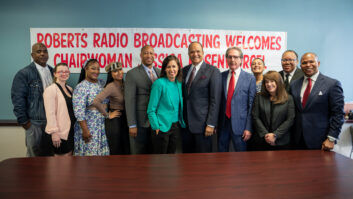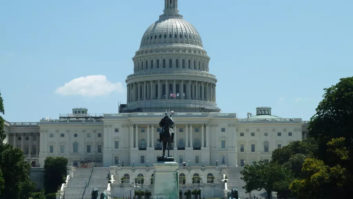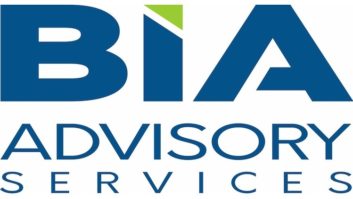The idea of allowing U.S. radio stations to “geo-target” content via FM boosters took a step forward this week.
We also got some insight into how several FCC commissioners are thinking about the proposal, with one describing the idea as a “potentially industry-altering technology.”
On Tuesday the Federal Communications Commission issued a notice of proposed rulemaking to allow limited geo-targeting, and asked for comments.
This proposal has been pushed for years by technology company GeoBroadcast Solutions LLC, and has gained support and interest from a number of influential industry players.
The FCC wrote that the idea “presents novel technical and public interest issues that would benefit from additional consideration.”
Geo-targeted content could include advertisements as well as other content. The NPRM would change the booster rules to “enable FM broadcasters to use FM booster stations to air geo-targeted content … independent of the signals of its primary station within different portions of the primary station’s protected service contour for a limited period of time during the broadcast hour.”
GeoBroadcast Solutions welcomed this step: “The prospect of hyper-localizing over-the-air radio content has great potential for the industry in reaching underserved audiences, as well as providing news and alerts on a regional basis, and improving the advertising revenue for the stations,” said spokesman Robert Udowitz. “Industry groups, media and advertising companies, broadcasting companies, minority coalitions and individual stations have all supported and seen the prospects for this technology.”
GBS has said that the technology will work without causing any adjacent-channel interference, and that any self-interference would be manageable.
We learn in statements issued by the commissioners that Brendan Carr, a Republican, and Geoffrey Starks, a Democrat, have been working together to bring the idea to this point.
Starks has been a more public supporter of the idea, emphasizing its potential benefit to small, women and minority broadcasters.
But Carr wrote after the NPRM was released, “We both saw the public interest benefits of this new technology, and I welcomed the chance to work with him and his team over the past few weeks and months to ensure that the commission launched this rulemaking.”
Carr calls the idea “potentially industry-altering technology that will allow FM broadcasters to deliver targeted content over their existing spectrum.”
He wrote, “This technology promises to enhance service in local markets and help these stations compete in an ever-expanding media marketplace. And it means that the freedom to transmit targeted or customized content, which mobile wireless carriers have long enjoyed and broadcast television stations are now realizing with ATSC 3.0, could soon extend to broadcast radio as well.”
Commissioner Michael O’Rielly, also a Republican but shortly to depart the FCC, took a more cautious view.
O’Rielly said he welcomes creative ideas intended to help “legacy providers to compete effectively with their unregulated counterparts.” But O’Rielly expressed reservations about the pace of the rollout, “given its substantial implications for reshaping FM radio policy and the radio advertising marketplace.” He said the FCC should not rush.
“This rulemaking’s embrace of new radio technologies seems to have occurred at almost light speed,” O’Rielly wrote. “In addition to these process-related concerns, there are also substantive reasons to proceed with caution. … Any rulemaking that considers taking steps that rely on a proprietary technology should be done under a watchful and extremely skeptical eye. It can take years, if not decades, to undue problematic regulations that contain embedded technologies.”
He said comments that will be filed in coming weeks will be important. “Geo-targeting will likely have different consequences for different stations, and it will be important for the record to flesh out the relevant benefits and drawbacks of more targeted ad sales,” he wrote.
“Some argue that increased targeting could expand ad sales by making smaller stations, and even boosters, more attractive to ad buyers. However, it is also possible, at the same time, that geotargeted ads will lower station revenues overall because these ads will be cheaper as a result of reaching fewer ears, leaving stations with a more limited product to offer and putting them in the position of having to recoup lost revenue.”
O’Rielly said that if advertisers can slice any given market into half a dozen mini markets, “it is possible they will only buy spots in certain neighborhoods and forego others, while potentially reallocating remaining funds to digital advertising or other media.”
In the best-case scenario, he said, stations would be under heightened pressure to sell even more ads, at a time when potential ad sales are already being lost to other media. “In the worst-case scenario, the door could be opened to allowing advertisers to entirely ignore certain neighborhoods or mini markets, placing an untenable strain on small stations or broadcast boosters that operate in these areas and harming consumers who live there. In the absence of more robust analysis, the assumption that these changes will promote diversity of voices, much less ownership, is incredibly premature.”
But Commissioner Starks has expressed no such reservations.
Starks pointed to the impact of the pandemic on small, minority broadcast owners, and said this proposal will help. He cited supported from civil rights organizations including MMTC, the National Association of Black Owned Broadcasters (NABOB), National Urban League and numerous others.
“The ability to use of booster stations to provide hyper-localized content potentially opens up opportunities for station owners to increase advertising revenue, which for struggling stations could increase their chance of staying on the air to serve their local communities. It could also provide a cost-effective means for other small businesses to customize advertising to a targeted audience.”
Another benefit, he said, is that it could help minorities gain more access to capital.
“GeoBroadcast Solutions has developed an advertising revenue sharing model that would help smaller stations install boosters and new technology necessary to use the system without having to come up with up front capital and operational expenses,” he wrote. “If this innovative proposal can provide a new revenue stream that keeps even a few struggling stations on air or opens up opportunities for new broadcasters to enter the market, it is well worth our serious consideration.”
The comment deadline will be set once the notice appears in the Federal Register.
Read the NPRM and the many questions the FCC wants comments about.











